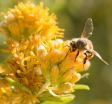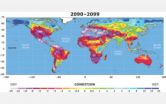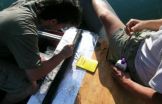Sniffing out shoe bombs: A new and simple sensor for explosive chemicals
2010-10-20
(Press-News.org) CHAMPAIGN, Ill. — University of Illinois chemists have developed a simple sensor to detect an explosive used in shoe bombs. It could lead to inexpensive, easy-to-use devices for luggage and passenger screening at airports and elsewhere.
Triacetone triperoxide (TATP) is a high-powered explosive that in recent years has been used in several bombing attempts. TATP is easy to prepare from readily available components and has been difficult to detect. It defies most standard methods of chemical sensing: It doesn't fluoresce, absorb ultraviolet light or readily ionize.
The few methods available to screen for TATP aren't feasible for on-the-ground use in airports, as they require large, expensive equipment, extensive sample preparation, or relatively high concentrations of TATP in solid or liquid form. There is no simple way to detect TATP vapor.
Kenneth Suslick, the Schmidt Professor of Chemistry at the U. of I., and postdoctoral researcher Hengwei Lin have developed a colorimetric sensor array that can quantitatively detect even very low levels of TATP vapor – down to a mere 2 parts per billion. They wrote about their findings in an article published in the Journal of the American Chemical Society.
To create the sensor array, the researchers print a series of 16 tiny colored dots – each a different pigment – on an inert plastic film. A solid acid catalyst breaks down TATP into detectable components that cause the pigments to change color, like litmus paper.
Each pigment changes colors depending on the concentration of TATP in the air. The array is digitally imaged with an ordinary flatbed scanner or an inexpensive electronic camera before and after exposure to the air.
"Imagine a polka-dotted postage stamp sensor that can sniff out the shoe-bomber explosive simply by using a digital camera to measure the changing colors of the sensor's spots," Suslick said. "The pattern of the color change is a unique molecular fingerprint for TATP at any given concentration and we can identify it in a matter of seconds."
The array is uniquely sensitive to TATP. Unlike many other chemical sensors, Suslick and Lin's array is unaffected by changes in humidity or exposure to other chemicals, such as personal hygiene products or laundry detergents. It also has a long shelf life, so airport security and other users can keep a supply on hand.
In addition to demonstrating their sensing technique with an ordinary flatbed scanner, the researchers also developed a functional prototype hand-held device. The portable instrument, designed to easily screen luggage or shoes, uses inexpensive white LED illumination and an ordinary digital camera similar to a cell-phone camera.
"The hand-held device makes the whole process portable, sensitive, fast and inexpensive," Suslick said. The hand-held sensor now is being commercialized by iSense, a senor manufacturer based in Palo Alto, Calif.
"One of the nice things about this technology is that it uses components that are readily available and relatively inexpensive," said David Balshaw, Ph.D. program administrator at National Institute of Environmental Health Sciences, which supported the project.
###
Editor's note: To contact Kenneth Suslick, call 217-333-2794; e-mail: ksuslick@illinois.edu. The paper, "A colorimetric sensor array for detection of triacetone triperoxide vapor," is available online.
END
ELSE PRESS RELEASES FROM THIS DATE:
2010-10-20
A study published Oct. 19 in the open access journal Public Library of Science (PLoS) ONE, shows that not just human memories fade. Scientists from Arizona State University and the Norwegian University of Life Sciences examined how aging impacts the ability of honey bees to find their way home.
While bees are typically impressive navigators, able to wend their way home through complex landscapes after visits to flowers far removed from their nests, the study reveals that aging impairs the bees' ability to extinguish the memory of an unsuitable nest site even after the ...
2010-10-20
The United States and many other heavily populated countries face a growing threat of severe and prolonged drought in coming decades, according to results of a new study by National Center for Atmospheric Research (NCAR) scientist Aiguo Dai.
The detailed analysis concludes that warming temperatures associated with climate change will likely create increasingly dry conditions across much of the globe in the next 30 years.
The drought may reach a scale in some regions by the end of the century that has rarely, if ever, been observed in modern times.
Using an ensemble ...
2010-10-20
Procedural sedation and analgesia is an essential element of care for children requiring painful procedures in the emergency department. The practice of combining ketamine and propofol, two common medications used in emergency departments, has become more popular. However, until recently, it was unclear whether this practice was superior to the use of either agent alone, especially in children.
Research led by Drs. Amit Shah, Gregory Mosdossy and Michael Rieder of the Schulich School of Medicine & Dentistry at The University of Western Ontario and Lawson Health Research ...
2010-10-20
AMES, Iowa – The eyes of sheep infected with scrapie – a neurological disorder similar to mad cow disease – return an intense, almost-white glow when they're hit with blue excitation light, according to a research project led by Iowa State University's Jacob Petrich.
The findings suggest technologies and techniques can be developed to quickly and noninvasively test for transmissible spongiform encephalopathies, progressive and fatal neurological diseases such as mad cow disease in cattle and Creutzfeldt-Jakob disease in humans. Petrich, in fact, is working to develop ...
2010-10-20
Clear-cut logging and related road-building in the 1950s and 1960s in southern Oregon's Siskiyou Mountains disrupted soil stability and led to unprecedented soil erosion made worse during heavy rainstorms, report University of Oregon researchers.
While logging practices have improved dramatically since then, the damaged landscape -- the removal of low vegetation that helps to protect hillsides during fires and rain -- continues to pose a threat into the foreseeable future, said Daniel G. Gavin, professor of geography, and postdoctoral doctoral researcher Daniele Colombaroli.
Their ...
2010-10-20
WASHINGTON, Oct. 19 – One of the main techniques for measuring and monitoring mental activity, called functional near infrared spectroscopy (fNIRS), can often be impaired because a person's hair gets in the way. But now, thanks to a team of researchers at the University of Texas at Dallas and the University of Texas at Arlington, a novel device called a "brush optrode" is providing increased sensitivity with fiber tips designed to thread through hair to enhance scalp contact.
Details of the device will be presented at the Optical Society's (OSA) 94th annual meeting, ...
2010-10-20
PHILADELPHIA (October 19, 2010)—Inflammatory breast cancer (IBC), an aggressive and rare malignancy, is often initially misdiagnosed as an infection or rash. However, getting the correct diagnosis quickly is critical for patients because the disease spreads beyond the breast in a matter of just days or weeks. With that in mind, leading specialists from The University of Texas MD Anderson Cancer Center and Fox Chase Cancer Center have written a review of the current scientific and medical understanding of IBC, which includes key information on diagnosis, imaging, treatment, ...
2010-10-20
OAK RIDGE, Tenn., Oct. 19, 2010 -- The Cold Triple Axis spectrometer, a new addition to Oak Ridge National Laboratory's High Flux Isotope Reactor and a complementary tool to other neutron scattering instruments at ORNL, has entered its commissioning phase.
The CTAX uses "cold" neutrons from the HFIR cold source to study low-energy magnetic excitations in materials. Cold neutrons are slower than their "thermal" neutron counterparts, and thus perfect for probing low-energy dynamics.
The instrument, which moves by way of air pads on an epoxy surface known as the "dance ...
2010-10-20
WEST LAFAYETTE, Ind. - While America continues to become more religiously diverse, the belief that America is a Christian nation is growing more intense, according to research from Purdue University.
"America is still predominantly Christian, but it is more diverse than ever," said Jeremy Brooke Straughn, an assistant professor of sociology who studies national identity. "At the same time, many people feel even more strongly that America is a Christian country than they did before the turn of the century. This is especially true for Americans who say they are Christians ...
2010-10-20
PULLMAN, Wash. - For the chance to watch the sun rise over Olympus Mons, or maybe take a stroll across the vast plains of the Vastitas Borealis, would you sign on for a one-way flight to Mars?
It's a question that gives pause to even Dirk Schulze-Makuch, a Washington State University associate professor, who, with colleague Paul Davies, a physicist and cosmologist from Arizona State University, argues for precisely such a one-way manned mission to Mars in an article published this month in the "Journal of Cosmology."
In the article, "To Boldly Go: A One-Way Human Mission ...
LAST 30 PRESS RELEASES:
[Press-News.org] Sniffing out shoe bombs: A new and simple sensor for explosive chemicals



